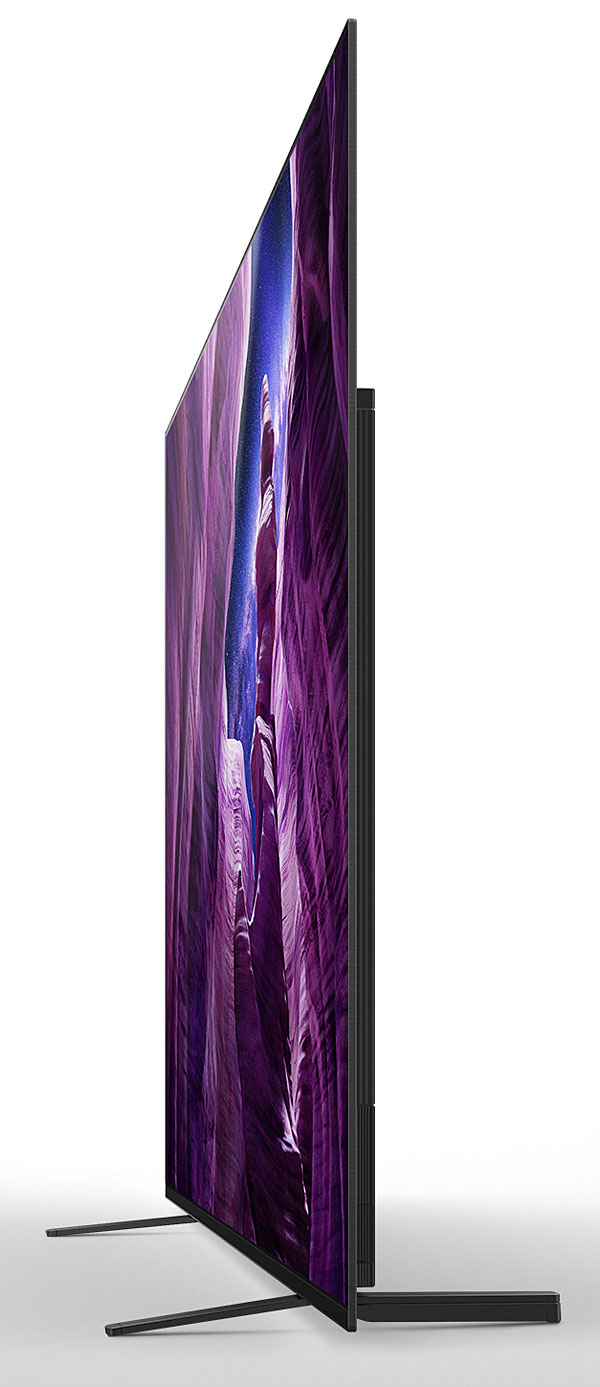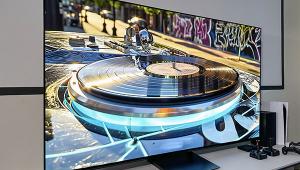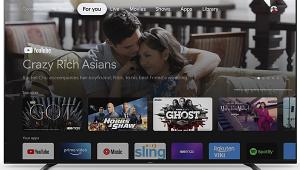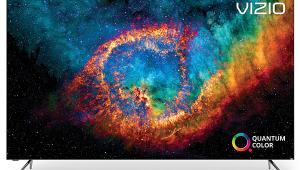Your review did not mention any offering of HDR10 Plus on this set, but I presume it has it because last year's model did. This is an advantage over the LG, which stubbornly does not offer it, and is one reason I would recommend this set over the LG. I presume also that the panel itself on this set is still made by LG, which was also not mentioned. The only difference is in the electronics applied to the panel.
Sony XBR-65A8H OLED Ultra HDTV Review Page 2
HD/SDR Performance
All of the disc-based material used in this review was played using an Oppo UDP-203 player. I saw no posterization (false contouring) from the Sony with any of the SDR or HDR material I watched. Neither did I see any obvious streaking, dirty screen effect, or other uniformity issues (though such issues can vary with the specific sample of any flat-panel TV). Off-center viewing produced no visible change in picture quality—a major advantage OLEDs offer.
With the 65A8H properly adjusted, its screen would go totally black on scene changes (source material permitting) when viewed in a fully darkened room. The black bars on letterbox films also remained consistently inky and invisible.

I often begin my HD/SDR assessment of a TV with a pair of Blu-ray test discs created by Samsung and Pioneer, respectively, that were produced for internal testing or demo use. The Pioneer disc (from 2006!) was designed to show off that company's then state-of-the-art Kuro plasmas and contains a string of sequences ranging from dark and difficult, to bright and colorful. This disc looked at least as good on the Sony as I've ever seen it, and was in some ways better. The only place where the 65A8H faltered was a five-second shot of a shadowed steeple against a darker background. This shot, which has tripped up other sets, is an extremely difficult test and might be affected by small errors either in a set's reproduction of barely above black tones (an extremely tricky area to design around) or in its black level, or brightness, setting. I couldn't see the steeple on the Sony, but this was the only shot on this disc or any other I viewed for this review where I had reservations about the set's otherwise outstanding rendition of near-black detail.
The Samsung disc also contains torture test sequences for black level and shadow detail, plus color, skin tone, and sharpness—the latter including a breathtaking close-up shot of a cat where I could have counted its whiskers if it sat still long enough! The Sony also performed flawlessly with this disc.

You wouldn't guess that My Fair Lady was a film released in 1964 by watching it on Blu-ray. The restoration here may not be perfect, but most of the film looked breathtaking on the Sony. In particular, the detail in Henry Higgins' study, a wealth of organized clutter, was superbly rendered. I can't imagine a 4K version on Ultra HD Blu-ray disc exceeding this transfer, though I'd love to see one!
My Fair Lady didn't tell me much about black level and shadow detail, so for that I turned to an old favorite Blu-ray, Harry Potter and the Deathly Hallows Part 2. As Harry and his friends walk through a tunnel leading to Hogwarts (chapter 9), both the black and near-black tones in close-up shots were strikingly well-resolved. Even more impressive, as the sequence changed perspective to place the characters in the middle of the screen, the blacks around them remained solid rather than turning gray. And in chapter 12, as Voldemort and his minions gather on a hillside near Hogwarts waiting to commence their attack, the surrounding gloom was totally convincing even as the important details remained visible.
Ultra HD/HDR Performance
As with HD/SDR, I watched both streamed and disc-based source material for my Ultra HD/HDR tests. Except as noted, all comments here refer to disc-based sources, which provide a more consistent visual reference than streamed video.
One of my favorite animated feature films is Disney's Tangled. While not as stunningly animated as the more popular Frozen, to me it's a much better film. Tangled looked great on the Sony: colors popped, scenes were crisp without slipping into artificial edginess, and the images overall were as close to flawless as I ever expect to see.

As with My Fair Lady in the SDR discussion above, Tangled offers very few black level challenges, so I again turned to Harry Potter and the Deathly Hallows Part 2— this time on Ultra HD Blu-ray. Some have criticized this film for crushed-looking blacks in its many dark scenes, particularly the last 40 minutes or so during the siege of Hogwarts. But viewed on the Sony in my darkened room, the 4K/HDR results were gripping and clearly superior to the already excellent HD/SDR version. There's little in the way of bright color throughout most of this film, but what there was jumped out of the surrounding gloom in a startling but still natural way. In particular, a scene with Harry and Dumbledore in an ethereal train station revealed considerably more detail in HDR, including a reddish glow around some of the white lights that was completely missing in SDR.
Both Tangled and Harry Potter were HDR10 discs, but what about Dolby Vision on the Sony? The new Ultra HD disc release of Jaws offers Dolby Vision, and the transfer looked superb on the 65A8H, though there aren't many scenes in this film that make much use of HDR. On the other hand, episode three of the last season of Game of Thrones (The Long Night), available on disc in Dolby Vision, is a killer app for challenging a display's handling of black level and shadow detail. The GoT transfer isn't perfect (it's surprising that a TV production even attempted shooting in such challenging lighting), and there were numerous complaints from TV viewers who watched the high-def HBO premiere that it was so dark they couldn't make out what was happening. But viewing the same material on a 4K disc with HDR on a state-of-the-art OLED is a different story. Watched in Dolby Vision on the 65A8H, some of the choreographed action remained confusing (particularly the aerial dragon battle), but all of the important dark details were visible in my fully darkened room. There was never any confusion in my mind about how the battle was going.

Conclusion
Sony's primary competitor for the OLED crown to date (at least in the U.S.) is LG. And while our review sample of LG's 65GXPUA OLED had been shipped back to the company prior to my testing Sony's XBR-65A8H, precluding a direct comparison, I can say that both sets offer superb performance. (My gut feeling is the Sony looks a bit better, but since I'm three months out from my last viewing with the LG, don't take that to the bank.) The Sony does have the obvious advantage of automatically transferring an SDR calibration over to HDR with no additional calibration work needed. And the LG's leg up is that it offers VRR and ALLM—features the Sony doesn't have (though of interest primarily to gamers). The LG also offers HDMI 2.1 inputs, but other than eARC, which the Sony does provide, HDMI 2.1 is arguably of little or no significance on a 4K set for most existing source material.
What's clear in the final consideration is that Sony's XBR-65A8H was a joy to live with. If I didn't already own a 2018 OLED, it would definitely be on my short list for a new TV.
- Log in or register to post comments


Call me unreasonable, but my 75 inch Sony Z9D is sitting on a stand that's about 50 inches wide. Fortunately, I bought it before every TV manufacturer decided that every TV needs a soundbar sitting in front of it and therefore the legs need to be pushed all the way to the side (although the TV being reviewed isn't as bad as most sets now). Sony was nice enough at that time to let me spend $8000 on a TV without having to spend hundreds more on a stand to match the width.
I wasn't so lucky when I was shopping for a TV to replace a 43 inch Sony that was in my office that got zapped by a power surge. There wasn't even a 40 inch TV that was available that would fit on the stand I was using, so I moved a 40 inch TV from my guest bedroom to the office - one less TV sold.

How is ergonomics a category for rating a 65" TV that sits on a stand/wall??? Like....what is there about the ergonomics of a TV that you don't touch that could be worth providing a rating for? The remote control???


Thanks for the reply!

The lack of HDMI 2.1 inputs I feel is a bad decision by Sony especially with the PS5 on the horizon. I have several gamer friends and they all say they're waiting for OLED sets with 2.1 for the variable frame rates it supports. As for HDR10+, the fact that it's a Samsung product almost guarantees that it will never be supported by Sony or LG. I for one would never consider buying a Samsung until it supports Dolby Vision. Speaking of supports, I have to agree with AlecS about these ridiculously wide stands/legs. I also own a 75" Z9D which sits comfortably on a 36" wide stand with room to spare.

S&V should do a blind comparison between the "bes"t LCD and OLED 4ks.

It's a compelling option for those seeking top-notch picture quality without breaking the bank.

The Sony XBR-65A8H OLED impresses with unsurpassed contrast, superior color, and resolution. | Delaware Drywallers

That's great! It indeed claims its feature. replacement social security card

Explore a comprehensive review of the Sony XBR-65A8H OLED Ultra HDTV, delving into its performance, features, and overall user experience. Discover how this cutting-edge television sets new standards in picture quality and viewing pleasure.

It's good to see an informative article, glad to check this here. screen company

Thanks for sharing this review, I appreciate it. Pest Control Jackson Wyoming























































